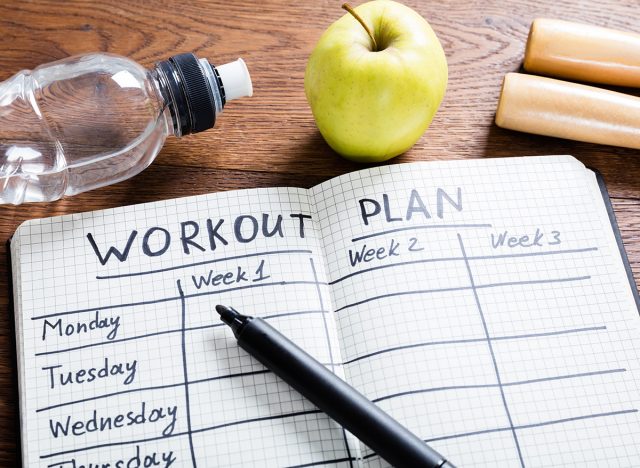I'm a Nutritionist and These are 7 Tips I Give My Clients for Lasting Results

When it comes to fitness, many of us experience the frustration of making progress only to lose it a few months later. This cycle of gains followed by setbacks—the infamous "yo-yo" effect—can make lasting success feel out of reach. For many, the focus is solely on achieving immediate results, such as losing a few pounds or building muscle. As a Registered Dietitian Nutritionist (RDN), Nutrition Consultant, and Body Data Practitioner, I tell my clients that fitness isn't just about reaching a goal; it's about maintaining it, and that's where most people go wrong. The common frustration comes from the lack of a long-term plan. Short-term approaches like crash diets or intense workout regimens might bring quick results, but they don't provide the tools to sustain them. Without a strategy for maintenance, old habits return, progress stalls, and people often feel defeated.
Why Does This Happen?

Many people focus solely on the end result without considering how they'll sustain their progress. They think about what it takes to lose 10 pounds or improve a mile time but rarely plan for how to maintain those results afterward. The key difference between short-term gains and long-term success lies in your mindset and approach.
Understanding Short-Term Planning

Short-term planning focuses on immediate changes, like daily gym visits for a month or following a 30-day diet challenge. While effective for a quick fix, these plans often lead to burnout or failure when life gets in the way.
Understanding Mid-Term Planning

Mid-term planning stretches across 3 to 6 months, focusing on achievable goals like building strength or improving endurance. However, even mid-term plans don't always address the lifestyle changes necessary to maintain fitness year-round.
Understanding Long-Term Planning

Long-term planning is about integrating fitness into daily life. It's not just about what you can achieve in the next few months but how you can ensure that fitness remains a priority for years. This approach includes strategies for overcoming plateaus, staying motivated during life's inevitable ups and downs, and balancing fitness with work, family, and other commitments. A critical aspect of long-term planning is using microcycles—short, repeated training cycles focusing on gradual progression. These microcycles, typically lasting 1-4 weeks, can emphasize different fitness components like strength, endurance, or flexibility. This approach makes fitness more manageable and keeps it interesting while allowing time for recovery and adaptation.
2 Common Issues and How to Address Them

Many people face two primary challenges in maintaining long-term fitness. The first is boredom or burnout. Sticking to the same routine without variation leads to both physical and mental fatigue. The pressure to achieve quick results can also lead to overtraining, injury, or frustration when progress slows. The second is a lack of maintenance mindset. Once people achieve their goal, they often revert to old habits. Without a maintenance plan, they lose the progress they've made.
Tips to Start Thinking Long-Term and Creating a Plan

Start Small: Think of your fitness journey as a marathon, not a sprint. Begin with manageable goals that you can build on over time. For instance, instead of committing to an hour-long workout every day, start with 20 minutes and gradually increase it.
Prioritize Maintenance: Once you reach a milestone, don't stop. Create a "maintenance phase" where you dial back the intensity slightly but remain active. This keeps your progress steady and prevents regression.
Balance Short, Mid, and Long-Term Goals: While short-term goals are important, make sure they align with your long-term vision. For example, if you're training for a marathon, your plan should include rest and strategies to maintain your running fitness afterward.
Think in Microcycles: Structure your workouts into 2-4 week phases focusing on different areas, such as strength or endurance. This variety prevents burnout, ensures balanced training, and keeps your body adapting properly.
Seven Key Factors

Now that we understand the importance of long-term planning and overcoming common pitfalls, let's dive into the seven evidence-based factors that can help you achieve and sustain long-term fitness success.
1. Consistency in Physical Activity

Maintaining consistent activity levels is a critical predictor of long-term success. Research shows that moderate, regular exercise, such as walking for 30 minutes daily, significantly reduces the risk of chronic diseases like cardiovascular disease and type 2 diabetes (1). Studies, including the CARDIA and Framingham Heart Studies, have consistently demonstrated that routine physical activity helps prevent weight gain and promotes sustained fitness.
How to Start
- Schedule workouts like appointments.
- Begin with manageable goals (e.g., 15-20 minutes of walking), and build over time.
- Keep a routine (e.g., cardio on certain days, strength training on others).
Pro Tip: Track physical activity with an app or journal to visualize progress and stay motivated.
Common Issue: "I don't have enough time for exercise."
How to Overcome It: Break workouts into short, 10-15 minute intervals throughout the day. Small bursts of activity, like taking the stairs or walking during breaks, still offer significant health benefits.
2. Combining Aerobic and Resistance Training

For optimal health benefits, combining aerobic exercises (e.g., cycling or running) with resistance training (e.g., weightlifting) yields superior long-term results. This dual approach improves cardiovascular health, builds lean muscle, and enhances metabolism (2). Studies show that combining these forms of exercise leads to more comprehensive fitness gains, compared to engaging in either type alone.
How to Start:
- Alternate between cardio and strength training on different days.
- Start with bodyweight exercises and progressively add weights.
- Aim for 150 minutes of moderate cardio and two days of strength training per week.
Pro Tip: Circuit training or high-intensity interval training (HIIT) allows you to blend cardio and strength in a single workout.
Common Issue: "I don't know how to balance cardio and weights."
How to Overcome It: Start by doing cardio on some days and weight training on others. As you become more experienced, consider combining both in a single session by alternating between cardio intervals and strength exercises.
3. Setting Realistic Goals and Tracking Progress

Setting achievable goals helps maintain motivation and adherence to fitness plans. Studies show that individuals who set specific, measurable goals are more likely to maintain their fitness routine (3). Tracking metrics, such as weight, body measurements, or workout performance, helps visualize progress over time and facilitates adjustments to achieve better results.
How to Start:
- Use SMART goals (Specific, Measurable, Achievable, Relevant, Time-bound).
- Track metrics like weight, body measurements, or fitness improvements.
- Use photos or journals to document changes over time.
Pro Tip: Celebrate small wins, such as lifting more or running faster, to stay motivated.
4. Varied and Enjoyable Exercise Routines

Sticking to the same routine can lead to boredom and plateaus. Incorporating variety into your workout program keeps you engaged, reduces the risk of injury, and challenges different muscle groups (4). Diverse activities, like swimming, hiking, and group classes, prevent burnout and encourage long-term participation.
How to Start:
- Switch up your routine every few weeks.
- Try different types of exercises, from swimming to strength training.
- Use fitness apps or challenges to explore new workouts.
Pro Tip: Creating a workout calendar that alternates between various types of activities ensures that you remain engaged and cover all muscle groups.
Common Issue: "I don't see results quickly enough."
How to Overcome It: Focus on non-scale victories, such as better sleep, increased energy, or improved strength. Remember, long-term progress often happens slowly and steadily.
5. Social Support and Community Engagement

Social support is one of the most reliable predictors of long-term fitness success. Studies have found that people who exercise with a partner or group are more likely to maintain their fitness routines over time (5). Social connections offer accountability, motivation, and fun, making fitness more enjoyable and sustainable.
How to Start:
- Join a local fitness group or find a workout buddy.
- Participate in online fitness challenges or virtual classes.
- Engage with fitness communities on social media for encouragement.
Pro Tip: Fitness apps with social features allow you to track progress and share milestones with your community.
Common Issue: "I don't have anyone to work out with."
How to Overcome It: Look for local fitness meetups, join online fitness groups, or participate in virtual fitness challenges to build a community of support.
6. Nutrient-Dense Diet Alignment

A balanced, nutrient-dense diet that aligns with fitness goals is key to sustaining progress. Research shows that diets rich in proteins, whole grains, fruits, and vegetables support muscle recovery, fat loss, and overall well-being (6). Aligning your nutrition with your fitness plan ensures that you stay energized and recover optimally.
How to Start:
- Focus on whole foods, lean proteins, and healthy fats.
- Aim for 0.8-1.2 grams of protein per kilogram of body weight, particularly after strength training.
- Plan meals in advance to avoid last-minute poor choices.
Pro Tip: Hydrate properly, especially before and after workouts, to boost performance and recovery.
Common Issue: "I struggle to stay consistent with eating aligned with my fitness goals."
How to Overcome It: Start small by gradually incorporating more of what you are missing (add one extra veggie, serving of protein on fruit per day) into your diet. Consider meal prepping on weekends to ensure you have balanced meals ready for the week ahead.
7. Rest, Recovery, and Stress Management

Rest and recovery are vital for long-term fitness success. Overworking muscles without proper recovery leads to injury and burnout. Additionally, stress management and quality sleep are essential for physical and mental well-being. Proper rest allows muscles to grow, and recovery days prevent fatigue and injury (7).
How to Start:
- Schedule at least one rest day per week.
- Aim for 7-9 hours of sleep per night to aid recovery.
- Use active recovery techniques, such as stretching or yoga, on rest days.
Pro Tip: Incorporate tools like foam rollers or massage guns to enhance recovery and circulation.
Common Issue: "I feel guilty for taking rest days."
How to Overcome It: Remind yourself that rest is essential for progress. Muscles grow and strengthen during recovery, not just during workouts, so rest days are critical to your long-term success.
Conclusion

Let's face it—there will be days when working out feels like the last thing you want to do. But here's the truth: showing up, even when it's tough, is what separates short-term effort from lasting success. Consistency doesn't mean perfection; it's about doing what you can, day in and day out, and trusting that each effort, no matter how small, brings you closer to your long-term goals. But it's not just about pushing yourself. Smart fitness is about balance. It's knowing that rest, recovery, and taking care of your body are just as important as pushing harder in the gym. It's embracing variety to keep your workouts fresh and enjoyable while making sure you're challenging your body in ways that make you stronger, not worn out.
Progress, Not Perfection

Remember this: Fitness success isn't a sprint—it's a lifelong journey. You're not just chasing a number on a scale or a certain look; you're building a lifestyle that supports your physical and mental well-being for years to come. **This is about you, your goals, and the life you want to live—strong, energized, and in control. Don't fall into the trap of thinking you need to be perfect. Some days, rest is what your body needs. Other days, you might need to adjust your diet or take a lighter workout. That's not failure—that's smart, sustainable progress. By thinking long-term, by planning and adjusting with purpose, you're giving yourself the gift of lasting change.
These Steps Will Help You Maintain Your Fitness for Life

These seven evidence-based strategies aren't quick fixes or overnight solutions—they're powerful, proven steps that will help you maintain your fitness for life. This isn't about short-lived progress—it's about creating a foundation for lifelong health and strength. You've got this. The journey may not always be easy, but it's worth it. With the right mindset and the right plan, success is inevitable. Stay committed, keep showing up, and always consult with a healthcare provider before making big changes. This is your journey, your story. Make it count. And if you enjoyed this article, take advantage of these 15 Quick Ways to Lose Body Fat Percentage in a Week.
References

- Ekelund, U., Tarp, J., Steene-Johannessen, J., Hansen, B. H., Jefferis, B., Fagerland, M. W., … & Lee, I. M. (2019). Dose-response associations between accelerometry measured physical activity and sedentary time and all cause mortality: Systematic review and harmonised meta-analysis. BMJ, 366, l4570. https://doi.org/10.1136/bmj.l4570
- Schroeder, E. C., Franke, W. D., Sharp, R. L., & Lee, D. C. (2019). Comparative effectiveness of aerobic, resistance, and combined training on cardiovascular disease risk factors: A randomized controlled trial. PLOS ONE, 14(1), e0210292. https://doi.org/10.1371/journal.pone.0210292
- Hallal, P. C., Andersen, L. B., Bull, F. C., Guthold, R., Haskell, W., & Ekelund, U. (2012). Global physical activity levels: Surveillance progress, pitfalls, and prospects. The Lancet, 380(9838), 247-257. https://doi.org/10.1016/S0140-6736(12)60646-1
- Janssen, I., Katzmarzyk, P. T., & Ross, R. (2004). Waist circumference and not body mass index explains obesity-related health risk. The American Journal of Clinical Nutrition, 79(3), 379-384. https://doi.org/10.1093/ajcn/79.3.379
- Dishman, R. K., Sallis, J. F., & Orenstein, D. R. (1985). The determinants of physical activity and exercise. Public Health Reports, 100(2), 158-171. https://www.ncbi.nlm.nih.gov/pmc/articles/PMC1424720/
- Kerksick, C. M., Wilborn, C. D., Roberts, M. D., Smith-Ryan, A., Kleiner, S. M., Jäger, R., Collins, R., Cooke, M., Davis, J. N., Galvan, E., Greenwood, M., Lowery, L. M., Wildman, R., Antonio, J., & Kreider, R. B. (2018). ISSN exercise & sports nutrition review update: Research & recommendations. Journal of the International Society of Sports Nutrition, 15(1), 38. https://doi.org/10.1186/s12970-018-0242-y
- Pate, R. R., O'Neill, J. R., & Lobelo, F. (2008). The evolving definition of "sedentary". Exercise and Sport Sciences Reviews, 36(4), 173-178. https://doi.org/10.1097/JES.0b013e3181877d1a




